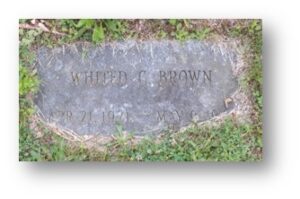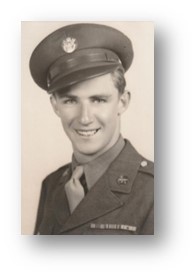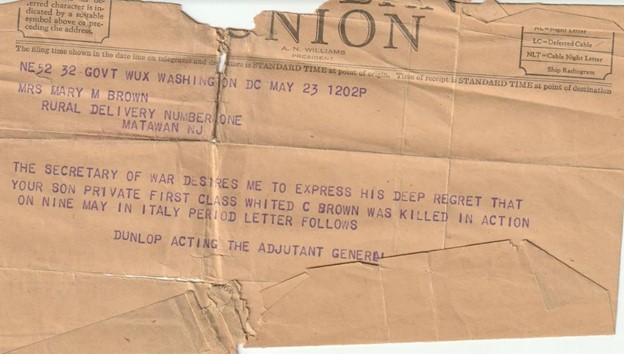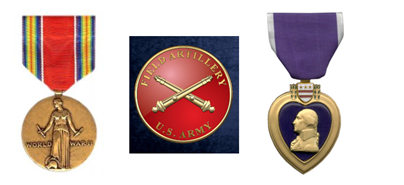Name: Brown, Whited “Bub” Carlton, PFC, USA
Local address: RD #1, Matawan, NJ
Whited, born April 21, 1921 in Cheesequake, NJ, was the second of three children of Louis Henry Brown (1895-1946) and Mary Matilda Quackenbush (1898-1991). The family operated an Esso station at the intersection of what is now Highway 34 and Amboy Road across the street from Big Ed’s Barbeque and lived adjacent to the business.
Whited attended Matawan High School, and was active in school affairs, being elected as vice president of the school’s Camera Club in 1937 and president of his home room in 1939. He apparently was in the MHS Class of 1940, but it doesn’t appear that he graduated. He had shown interest in becoming an airplane mechanic while attending the school in 1938, and in 1941 was a member of the Jersey Aero Club at Jumping Brook Airport in Neptune in 1941.
When he registered for the draft, he was working at the family service station and was described as 5’8”, 130 pounds, brown hair, blue eyes with a light complexion. The remark section indicated “glasses always.”
On October 20, 1942, he enlisted in the Army in Camden, with the record indicating he had three years of high school and was a “semi-skilled mechanic/repairman, motor vehicles.” His initial training was at Camp Carson in Colorado and then Fort Ord, CA as a ski trooper. He was assigned to the 609th Field Artillery Battalion and his first action was supporting infantry in the invasion of Kiska, Alaska.
The 609th was a mobile unit with troops trained in a portable, “pack” 105mm howitzer. This unit could be attached to glider outfits where the troops – and pack mules – could be landed behind enemy lines and provide artillery support for light infantry units.
 After Alaska, his unit was sent to Europe where Whited was killed in Italy on May 9, 1944. Hospital records indicate his diagnosis as “First Location: Upper extremity, generally; Causative Agent: Bullet, Missile Not Stated.” He apparently was given a blood transfusion at the time. Exactly where is unclear – it’s difficult to track the movements of small, unattached units like the 609th. He had recently written home and advised he had just seen a friend from high school, Arby Doyle, camped near to him. Doyle, who was wounded in action the following July (for the second time, having also been wounded the previous September), was assigned to a unit that was fighting at Monte Casino at that time, so Whited was most likely killed in that vicinity.
After Alaska, his unit was sent to Europe where Whited was killed in Italy on May 9, 1944. Hospital records indicate his diagnosis as “First Location: Upper extremity, generally; Causative Agent: Bullet, Missile Not Stated.” He apparently was given a blood transfusion at the time. Exactly where is unclear – it’s difficult to track the movements of small, unattached units like the 609th. He had recently written home and advised he had just seen a friend from high school, Arby Doyle, camped near to him. Doyle, who was wounded in action the following July (for the second time, having also been wounded the previous September), was assigned to a unit that was fighting at Monte Casino at that time, so Whited was most likely killed in that vicinity.
His older brother James was a decorated US Army Air Corps A-20 bomber pilot. After Whited’s death, he named his aircraft “Bub’s Brother.”
Whited had arranged for a florist to deliver a dozen roses to his mom for Mother’s Day, which arrived a week after his death. Upon delivery, the florist noted there were thirteen roses instead of a dozen and remarked to her that he hoped she wasn’t superstitious. His body was returned to the US in 1948 and is buried in the Old Tennant Churchyard.
MHS appreciates the photo and copy of the telegram provided by Whited’s sister Joan’s son, Louis Green.



NO COMMENTS